The Fine Arts Work Center hosted a lush and virtuosic exhibition last summer titled “Glitch Aesthetics.” In it were two heads by Alicia Henry, crudely cut from stained fabric, their features rendered with stitching and holes. They stood out like unrefined guests at a glitzy party, raw and honest.
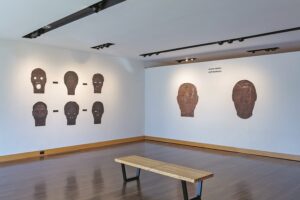
This year, Henry’s work has returned to Provincetown in a solo exhibition at PAAM, displayed in its street-facing gallery. In this show — all heads cut from fabric — she elaborates on the work she presented at FAWC last year.
Each wall of the exhibition features a group of heads. Henry plays with scale and relationships throughout the show. On the front wall, beneath the show’s title, Autonomous, are two of the largest heads. Like all the heads, they are disembodied, their features stitched onto the canvas from which the forms were cut. The longest wall displays a larger grouping of male and female figures displayed horizontally. On the other walls she arranges the figures more playfully: in a grid, in descending size, interrupted with bits of horizontal and vertical marks.
All of the figures are black, evident in their features and the dark cloth from which Henry cut them. The pain of the African American experience — and the embodied trauma — resonates in the work. The expressions are somber, the materials distressed. In some pieces, she works with a canvas surface that appears to have come from her studio floor, marred with spills, stains, and cuts. A pink stain runs through the right side of the face in one oversized portrait of a man with eyes closed. His face is marred by red and white stitches cutting across the form.
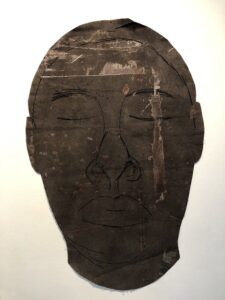
“She uses stitching to create scars and heal scars,” says Marian Roth, who curated the show with Ngina Lythcott. “It’s not gruesome. It’s just what it is. Her work isn’t didactic.”
Although metaphor can be read into Henry’s use of material, there’s also a matter-of-factness to the fabric and her use of line, which doesn’t try to hide the messy, physical process of creating the work and making things in a studio — or living in a body. The edges of her cutouts are frayed. She doesn’t shy away from material and physical stresses and constraints. And yet, her figures maintain a quiet dignity. They’re larger than life, monumental even. Their eyes are either closed in self-composure or looking straight ahead, beyond the viewer.
What’s striking about the figures in this show is their ability to feel simultaneously solitary — or autonomous — and also part of a group. The portraits are of individuals, yet their individuality is not underscored. “They’re very generic,” says Henry. “They could be many different things or experiences.” The only interaction is spatial; their gaze never turns upon each other. Visually, the repetition feels redundant, but conceptually it’s significant. There’s unity and strength in their multitude. Their identity is collective. Likewise, the show functions as an installation rather than a collection of distinct pieces.
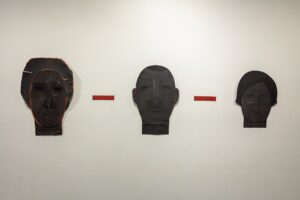
Henry, who lives in Nashville where she is professor of art at Fisk University, spent two years in Provincetown as a fellow in the early 1990s after finishing graduate school at Yale. Roth met Henry when photographing her artwork. “It blew me away,” says Roth, who traded her photographs for two of Henry’s pieces. “This was the ’90s and there wasn’t a lot of art around where you could see a black artist making art from that experience.”
The two reconnected in 2000 when both won Guggenheim awards. Roth proposed that PAAM mount an exhibition of Henry’s work. “I made a conscious decision to push her work,” says Roth. “I was totally compelled.”
Henry says the exhibition title conveys “an idea of being who you are and finding strength in the independence of that. These strong faces have gone through things, are going through things, and finding strength,” she says.
As a young artist working in Provincetown, Henry found ways to develop her own autonomy. “The residency gave me space to take risks and experiment without the pressure to fit into some other mold — to be who I was becoming,” she says. It also helped her decide to step aside from her trajectory as a professional artist. Immediately after leaving Provincetown, she spent two years teaching art as a Peace Corps volunteer in Ghana.
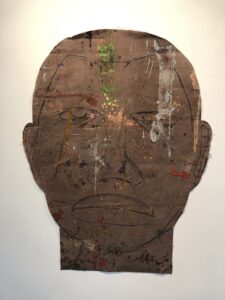
In the PAAM show, it’s unclear where her figures are heading — or where they are. Roth points to one figure on the rear wall in the exhibition. We see only the back of the figure’s head, its silhouette marked with constellation-like stitches of white thread.
“This figure is going somewhere, wherever it is,” says Roth. The work amplifies an existential note that echoes throughout the exhibition. Henry is asking perennial, universal questions: Who are we, where are we, and where are we going? Questions and a journey we work out in community, but which, ultimately, we face alone.
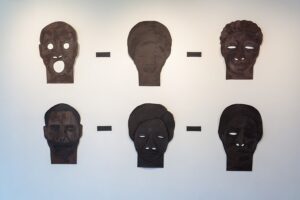
Autonomous
The event: An exhibition by Alicia Henry
The time: Through July 9
The place: Provincetown Art Association and Museum, 460 Commercial St.
The cost: General admission: $15
